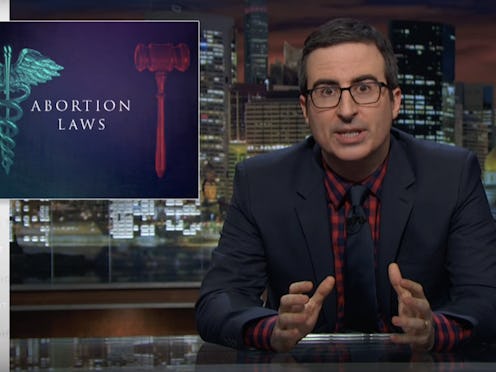News
Oliver Explains Whole Woman's Health Succintly

On Monday, the Supreme Court handed down one of the biggest abortion rulings in a decade. The court's progressive four were joined by Justice Kennedy in a 5-3 decision striking down parts of a restrictive Texas abortion law, claiming it placed "undue burden on abortion access." The law would have shuttered all but 10 of the state's clinics. So yes, it's a huge win. But why, exactly? Back in a February episode of Last Week Tonight, John Oliver explained why the Whole Woman's Health case had such high stakes. Watch it to understand the importance of today.
To start with, abortion is still legal in the United States, thanks to the Supreme Court's 1973 ruling in Roe v. Wade. However, that hasn't stopped states from trying to regulate the procedure. That's what the Texas law which SCOTUS partially struck down today tried to do, for example. It required abortion providers to have admitting privileges at local hospitals, and abortion clinics to meet the standards of "ambulatory surgical centers" — which would have required most to revamp their buildings, equipment, and staffing (all of which is unnecessary and unaffordable).
Oliver tore apart these state abortion laws, calling them TRAP (Targeted Regulation of Abortion Providers) laws. He cited an Associated Press article and explained that about 70 abortion clinics have closed due to similar state-level laws since just 2010. They can be so extreme that at least four states, North Dakota, South Dakota, Mississippi, and Missouri have only one abortion clinic remaining. "Yes, Mississippi now has four times as many S's as it has abortion clinics."
The 1992 Supreme Court case Planned Parenthood v. Casey said that government could pass restrictions on abortions as long as they didn't create an "undue burden" which places a "substantial obstacle in the path" of women seeking abortions (you'll note the same wording in today's ruling). Since then, anti-abortion activists have pushed states into passing laws that are on the surface aimed at protecting women's health and safety. But Oliver's not buying it, "When you’re that insistent about women’s health, it starts to sound suspicious. It’s like having a folder on your computer called ‘Definitely Not Porn.’ You’re not fooling anyone."
Plus, what message do these laws send women? As Oliver put it, "Women can be jumped through a few hoops, just not too many. Which might sound a little less insulting if those weren't also the rules for a dog agility course." And more often then not, the hoops don't make any medical sense. The TRAP law in Texas, HB2, which was struck down Monday, affected one clinic which had hallways three feet wide. The new surgical center regulations called for hallways eight feet wide so that two gurneys could pass each other. That's not going to happen in a small abortion clinic, where most abortions are non-surgical.
To give you an idea of just how safe legal abortions already are, Oliver broke out some stats from the CDC. The abortion-related death rate is 0.00073 percent. Oliver pointed out that's about 10 times lower than the risk of dying from a colonoscopy, "one of the worst ways to die."
The same hypocrisy applies to HB2's bit on admitting privileges. Many hospitals won't let abortion providers scrub in for political or religious reasons, which can then limit their ability to work in rural areas. Oddly, though, in Texas, providers at "birthing centers" don't need admitting privileges at hospitals, even though about 12 percent of the women giving birth there end up being transferred to a hospital — scores more than women receiving abortions.
In the end, it's all about access. As Oliver put it, "Abortion cannot just be theoretically legal. It has to be literally accessible." And thanks to the Whole Woman's Health v. Hellerstedt decision, it is ... at least a bit more than it would be in a world with HB2. Oliver ended the segment with a video of baby sloths. It's cute, but you can skip it today if you want, because there is much to celebrate.